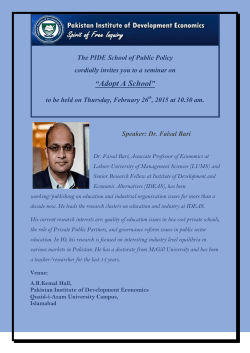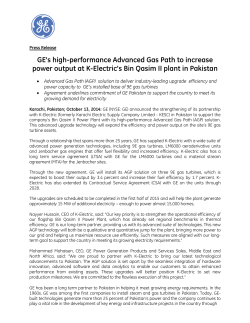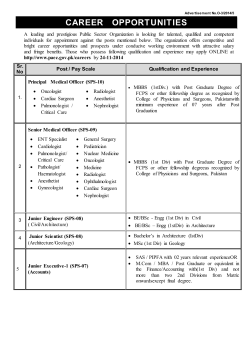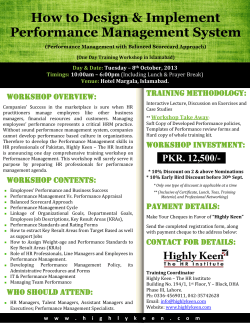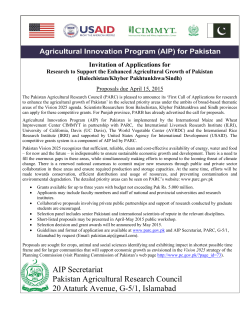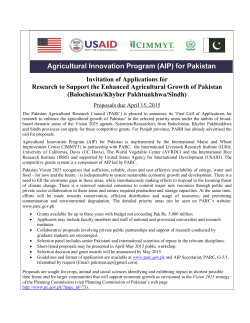
Report Pakistan`s Trade Relations with India NDMA, Challenges
YOUTH PARLIAMENT PAKISTAN YOUTH PARLIAMENT PAKISTAN YOUTH PARLIAMENT PAKISTAN YOUTH PARLIAMENT PAKISTAN YOUTH PARLIAMENT PAKISTAN YOUTH PARLIAMENT PAKISTAN YOUTH PARLIAMENT PAKISTAN YOUTH PARLIAMENT PAKISTAN YOUTH PARLIAMENT PAKISTAN YOUTH PARLIAMENT PAKISTAN 6th Youth Parliament Pakistan A Report on Pakistan's Trade Relations with India: NDMA, Challenges, Way Forward and Implications March 2015 Secretariat Youth Parliament Pakistan YOUTH PARLIAMENT PAKISTAN YOUTH PARLIAMENT PAKISTAN YOUTH PARLIAMENT PAKISTAN YOUTH PARLIAMENT PAKISTAN YOUTH PARLIAMENT PAKISTAN YOUTH PARLIAMENT PAKISTAN YOUTH PARLIAMENT PAKISTAN YOUTH PARLIAMENT PAKISTAN YOUTH PARLIAMENT PAKISTAN YOUTH PARLIAMENT PAKISTAN 6th Youth Parliament Pakistan A Report on Pakistan's Trade Relations with India: NDMA, Challenges, Way Forward and Implications March 2015 Secretariat Youth Parliament Pakistan PILDAT is an independent, non-partisan and not-for-profit indigenous research and training institution with the mission to strengthen democracy and democratic institutions in Pakistan. It also serves as Secretariat, Youth Parliament Pakistan. PILDAT is a registered non-profit entity under the Societies Registration Act XXI of 1860, Pakistan. Copyright © Pakistan Institute of Legislative Development And Transparency - PILDAT All Rights Reserved Printed in Pakistan Published: March 2015 ISBN: 978-969-558-486-6 Any part of this publication can be used or cited with a clear reference to PILDAT. Secretariat, Youth Parliament Pakistan Islamabad Office: P. O. Box 278, F-8, Postal Code: 44220, Islamabad, Pakistan Lahore Office: P. O. Box 11098, L.C.C.H.S, Postal Code: 54792, Lahore, Pakistan E-mail: info@youthparliament.pk | Website: www.youthparliament.pk Y O U T H CONTENTS Preface Executive Summary List of Abbreviation Members of the Youth Parliament Standing Committee on Foreign Affairs Introduction Historical Perspective Current Perspective Background and Findings Technical Aspects of NDMA Trade Regulations Non-Tariff Barriers Challenges and Implications Domestic Politics and Opinion Role of the Military Industries and Sectors Agriculture Sector Automotive Sector Pharmaceutical Sector Trade and Conflict Resolution Improved Trade Relations Impact on Peace Process & Conflict Resolution Model Economies China India Recommendations Bibliography Annexure 13 13 13 13 13 13 13 14 14 14 15 15 15 15 15 15 16 16 16 16 17 18 19 Y O U T H PREFACE PREFACE A fter the successful completion of 5 terms since 2007, the 6th Youth Parliament Pakistan was launched in June 2014. The specific objectives of the Youth Parliament Pakistan (YPP) programme are to inculcate democratic culture and spirit of tolerance for others views among the youth; to expose them to the political and parliamentary processes; to facilitate youth to express their views on various national, international, regional and local issues thereby helping the government and society at large to better understand the concerns of the youth; to groom the leadership potential of the youth of Pakistan by exposing them to peaceful and democratic resolution of differences especially at a time when various parts of Pakistan are suffering from conflict and extremism. Finally this provides a forum to the youth of Pakistan to understand how the Parliament works as the supreme public representative institution in a democracy. The YPP has its own 2-party system, Leader of the House and Opposition, as well as an augmented system of Parliamentary Committees with Committee Chairpersons, Vice Chairpersons and Secretaries. The Youth Parliament Standing Committees of the 6th Youth Parliament Pakistan (2014), as a part of the learning process, have been tasked with conducting reviews of national policies through research based analysis and with developing cogent policy alternatives for the Parliament and the Government of Pakistan. The six Youth Parliament Standing Committees for the current term are: - Youth Parliament Standing Committee on National Security Youth Parliament Standing Committee on Foreign Affairs Youth Parliament Standing Committee on Energy Youth Parliament Standing Committee on Law, Justice & Human Rights Youth Parliament Standing Committee on Education & Youth Affairs Youth Parliament Standing Committee on Finance, Economic Affairs & Planning The Committees have gone through a process of intensive research, consultations with policy experts and internal review within Committees before putting together their proposals. The initial findings were shared with the Secretariat Youth Parliament Pakistan and the Steering Committee Youth Parliament Pakistan who gave their comments on these drafts. After incorporating these inputs, the reports are finalized by individual Committees and thereafter presented on the floor of the House for further recommendations and feedback from the entire strength of the YPP. Going through this rigour the participants not only experienced the process of drafting policy in a democratic fashion but also formulated useful recommendation in the form of this report, The reports are compiled and finally published for the purpose of dissemination through media briefing and report launch event at the closure of third YPP Session of the 6th YPP term. More importantly all the reports will be presented by the Members of YPP to the corresponding Standing Committees of the National Assembly and Senate, in the effort to incorporate the voice of the youth in the national policy making process. The authors of the reports, the MYPs, are to take the lead in lobbying for the recommendations they have devised, to civil society, media and to a greater audience. The reports are also available online at www.youthparliament.pk. The 6th Youth Parliament Pakistan (2014-2015) is supported by the Danish International Development Agency, Government of Denmark, as recognition of the importance of young people's development in democracy and democratic practices. Disclaimer The Secretariat of Youth Parliament Pakistan has provided unbiased feedback in a timely manner on the research reports and the scientific value of the work done by MYP's. The Secretariat has given guidance in ensuring the content is clear, concise, and relevant to the current pool of knowledge in regard to originality, and interest to the readers. The opinions, findings or recommendations expressed in this report belong to the authors and do not reflect the views of PILDAT or DANIDA. Secretariat of the Youth Parliament Pakistan Pakistan institute of Legislative Development and Transparency March 2015 05 Y O U T H EXECUTIVE SUMMARY EXECUTIVE SUMMARY E conomic liberation can usher an era of peace, stability, reciprocal progress and mutual trust among Pakistan and India. These acrimonious states share a history of mistrust and economic aloofness, which not only retarded economic growth but created misconception among masses. The long standing political issues: Siachen, Sir Creek, Kashmir and violation of riparian rights regarding Indus water Treaty pose as hindrances. Though history bespeaks a dismal scenario, but the future should seek a departure from the past events. With the inevitable and irreversible age of globalization and regionalism, economic co-operation is not merely a choice but an indispensable necessity. Impelled by these necessities, India and Pakistan are willing the extend NonDiscrimination Market Access to each other. It is extremely beneficial because it reduces the bilateral pressure from large powers. It requires relaxation of stringent restriction on bilateral trade relation, by reducing non-tariff barriers and other limitation. It requires easy and smooth flow of goods and other trade items. Besides this, trade is regulated while aiming at profit maximization. At this crucial juncture of history when new political actors are reining their respective countries, change is in the offering. But the baggage of history cannot be denied. There are vital and serious stumbling blocks which pose considerable resistance. The military still holds a dominant position in both countries, and in case of Pakistan this assumption has been vindicated time and again. It hinges its legitimacy and its domineering role on the pretext of security and survival of the country. Thus they conveniently discourage such developments. As long as military continue steering the wheels of foreign policy, the prospects are bleak. The citizenry of each country also harbor negative stereotypical perceptions towards each other's. The hawks have been successful to scuttle the process of bilateral trade ties by hysterical provocative statements. They presented it as the negation of two nation theory. Certain industrial sectors like agricultural industry and pharmaceutical industry deem it an onslaught on their productivity, because the flood of Indian goods will ruin our nascent industries. Nevertheless there is a need to move forward and more importantly stay at par with the rest of the world. Therefore Pakistan and India need to resolve their trade issues and proceed with a reduction in their non-tariff barriers, dismantling of negative lists, carefully calculating each other's subsidy regimes and also lay emphasis on enhancing people to people contact through cultural exchange programmers and via liberalization through various forums such as SAARC. 07 Y O U T H List of Abbreviation MFN NDMA SEA WTO LOC SAARC NTB FDI BJP TLP SAFTA BIS GDP DRAP FDA EU PPP Most Favoured Nation Non Discriminatory Market Access South East Asia World Trade Organization Line of Control (Border between Pakistan & India) South Asian Association for Regional Cooperation Non-Tariff Barriers Foreign Direct Investment Bharatiya Janata Party (Political party in India) Trade Liberalization Program South Asian Free Trade Area Bureau of Indian Standards Gross Domestic Product Drug Regulatory Authority of Pakistan Food and Drug Administration European Union Purchasing Power Parity 09 Y O U T H Members of the Youth Parliament Standing Committee on Foreign Affairs Daniyal Alvi Chairman (YP50-SINDH03) Ramiz Ali Malik Vice Chairman (YP58-SINDH11) Filza Marri (YP52-SINDH05) Hunza Jamil Secretary (YP32-PUNJAB13) Malik Muhammad Danish (YP29-PUNJAB10) Javaid Ali Manwa (YP09-GB01) Musirah Farrukh (YP40-PUNJAB21) Ali Shan Khan (YP13-KP01) Tassawur Mehdi Kazmi (YP10-GB02) Asmatullah Asmi Youth Minister for Foreign Affairs (YP04-BALOCHISTAN02) 11 Y O U T H Introduction Historical Perspective In 1947, at the dawn of a new frontier in history, India still accounted for 70% of Pakistan's trade. However, as tensions between the newly independent countries escalated, trade suffered severely, dropping to almost negligible between 1965 and 1973. Some development in trade relations took place in 1989 when Pakistan introduced a positive list of goods, with the number of goods increasing every year from then on. After the establishment of the World Trade Organization in 1995 India gave Pakistan ‗Most Favoured Nation'(MFN) status, however Pakistan has yet to grant India the MFN status. This MFN is now termed as Non-Discriminatory Market Access (NDMA). The World Trade Organization (WTO) explains NDMA as follows: “A method of preventing discriminatory treatment among members of an international trading organization. It provides trade equality among partners by ensuring that an important country will not discriminate against another country's goods in favor of those from a third. Once the importing country grants any type of concession to the third-party country, this concession must be given to all other countries.” During the 1990s progress could not be made on the MFN status due to constant political turmoil in Pakistan. This was followed by conflict with India in Siachen which led to a regime change, whereby Pakistan became a military dictatorship and relations with India deteriorated. In 2011, work on granting the MFN status gained momentum again with a civilian regime in place in Pakistan; the last update coming in 2012, with the cabinet unanimously deciding to give India MFN status, in principle, as per treaty obligation. Nevertheless, it was made clear that the MFN only means that Pakistan will not discriminate against India and that trade restrictions will remain, but granting MFN status would make it easier to remove them. After this move bilateral trade began to improve and Pakistan introduced a negative list, instead of positive list of items allowed for export into the country. India reciprocated by allowing Foreign Direct Investment from Pakistan. The two countries have also simplified trade procedures to facilitate trade, yet there is space for better trade relations to the benefit of both countries. In 2013 the discussion on MFN status was put on hold during elections in India ―We also deferred this due to elections in India because we did not want to favor single political party in India, the then Prime Minister commented on the matter. Current Perspective In 2014, with the BJP in power in India, talks have gained new momentum. Pakistan renamed the MFN to Non Discriminatory Market Access (NDMA) as a counter to the suspicion attached to the term. Talks have been underway in sorting out the details for granting the NDMA, but have been impeded by any growth in hostility on the line-of-control, along with also being subject to the different lobbies. The latest session of talks was scheduled for 25th August but was cancelled by India on the grounds that Pakistan interfered in India's internal matters when Pakistan's high commissioner in Delhi consulted Kashmiri separatist leaders ahead of the talks. Hurdles remain in the way of granting full NDMA status but it may now only be a matter of time before borders open up to more regularized and open trade. Background and Findings Technical Aspects of NDMA The formal grant of MFN status to India by Pakistan will trigger the Trade Liberalization Program (TLP) under SAFTA rules and Pakistan and India will be required to reduced Sensitive List', while lowering the tariffs to 0-5% on the imports of goods from each other and also from all other registered SAFTA members. Trade Regulations The grant of MFN to Pakistan by India, India's market opening to Pakistani goods is seen more restrictive for the following two factors: 1. 2. The higher proportion of Tariff lines pertaining to Agriculture and Textile retained by India on its Sensitive List. The potential undermining of greater market access to Pakistani Textile export in India by the latter's already existent preferential trade agreements with Bangladesh and Sri Lanka Non-Tariff Barriers The following are some of the other NTB's India has employed on Pakistan: 1. The BIS (Bureau of Indian Standards) Certification is an obligatory requirement imposed by the Indian Government across the board for all countries for products like cement who's BIS Certification is very expensive and is valid for only 1 year. The renewal time of the certificate is 13 Y O U T H 2. 3. 4. 5. 6. 7. supposed to done in 3-4 weeks but in case of Pakistani's Companies exporting ((M/S DG Khan Cement, L/S Lafarge and M/S Lucky Cement) cement to India takes even 6 months. The Indian security system for Pakistani goods and passengers is also a major NTB which causes delay in clearance of goods. Due to no Direct Banking Arrangements between the two countries; the payments are done through an International Bank or through informal channels which causes increase in transaction cost and delay. No warehousing facilities and no cold storage facilities at either side of the borders with time constraint makes very trading very difficult for traders. The imports of Fabrics in India are subjected to the SGS and OEKOTEX testing and certification which is an obligatory requirement for all the exporters. Any exporter who is exporting fruits and vegetables to India are posed to go through the quarantine rules and requires an import permit from the Director General of Foreign Trade, Government of India. Along with SGS testing and certification the finished leather requires an additional certification from the Veterinary Department of India. Challenges and Implications Domestic Politics and Opinion In the current scenario, there exists to some extent, cross-party consensus for having cordial and friendly relation with India. Prime Minister Nawaz Sharif has repeatedly been a promoter of such an agenda, whereas the response from the other side of the boundary has always been indifferent, with the exception of being in favor of trade and business development. The former Indian premier, Manmohan Singh seemed to approve of better relations between the two countries, however his political will and constant domestic challenges resulted in the agenda never really being given due importance. Now with a newly elected premier of India, Narendra Modi, there is a whole new dimension to the equation; on the one hand he is extremely probusiness and trade, however his dealings with Muslim's in his state, coupled with comments about Pakistan in general do not bode well. Nevertheless, both nations, at least about issues regarding business, seem determined proceed further and make things happen. In the recent meeting between the commerce ministers in New Delhi they discussed several important measures to accept liberalization as 14 well as facilitation actions. Crucial between these kind of seemed to be usually the one to help keep this Wagah-Attari border functional at any hour, introduce containerization regarding shipments and grant NonDiscriminatory Market Access (NDMA) on a reciprocal basis. The NDMA terminology is an attempt to remove any ill-conceived notions linked to the Most Favoured Nation (MFN) acronym. In March 2012, Pakistan succeeded in moving from a positive list approach to a negative list by putting 1209 items out of over 8000 items that could be imported to India. Furthermore integral business houses from both countries have developed friendly relations and there has been a rise in involvement of Pakistani exporters in Indian exhibitions and trade fairs. Disappointingly though, trade figures between Pakistan and India have never risen above the 1947 and 1965 levels. This is a clear indication to the leaders of both nations that unless there exists advancement on a range of issues, it may be challenging to achieve and maintain trade as well as business harmony. Role of the Military The Military has been more of a factor from Pakistan's end as compared to the Indian side. Pakistan has gone through numerous periods of Military rule, which have produced periods of economic liberation and growth, but have not achieved the same in terms of its dealings with their hostile neighbour's, India. There are common bonds in terms of culture and everyday dealings; however very rarely has there been any collective hegemony. Both countries have worked on different models of economic integration, that have helped developed their individual economies, but have not resulted in regional cooperation or benefit. India grew as relatively stable and constant democracy; however Pakistan has spent four phases of military rule which in effect have been dictatorships, along with a consistent struggle against insurgency and terrorism. This clash of political systems has been a contributor in never allowing an understanding to mature. More important than any other is the Kashmir dispute which remains an ever existent threat. The tensions only seem to seize for a limited period of time before once again flaring up, resulting in breakdown of any talks that may have been taking place. Both armies continue to stand guard on either side of the border, with infrequent confrontation as is the case currently. Both countries possess nuclear arsenal as a determent Y O U T H but recognize that clashes in Kashmir cannot be tolerated and may result in escalation. India and Pakistan must realize that trade normalization and peace will continue to face setbacks unless they commit themselves to preventing incidents that may affect their trade relations negatively. Industries and Sectors Agriculture Sector The Agriculture sector is one of the most important constituent of both India and Pakistan's economy. It contributes 21.4% of Pakistan's GDP (2012-2013) and 14.1% of India's GDP (2012-13). Moreover, 45% of Pakistan's labor force and 58% of India's labor force is dependent on this sector. Although the two countries have similarities in the structure of agricultural production but they differ in terms of agricultural policies. India, driven by the objective of achieving food security for its population, has maintained an interventionist regime in agriculture by subsidizing agricultural inputs and providing price support. In contrast, agriculture has minimal state intervention in Pakistan. The only crop procured by the govt. at a fixed pre-announced price is wheat, the rest are freely trade at market prices. Agriculturists in Pakistan are very vocal in their opposition to granting NDMA status to India as the difference in policy regimes creates an uneven playing field. Moreover, Non-Tariff Barriers on Indian side such as health and quality standards restrict the Pakistan's agriculture exports. On the other hand, Pakistan can also benefit from exporting citrus fruits and mangoes to India. Two possible solutions have been suggested to overcome this issue. The first one is that agricultural products be put on sensitive list on which tariffs could exceed NDMA tariffs. These higher tariffs would ensure a more level playing in the presence of large Indian subsidies to its farmers. The second option proposed by Pakistani agriculturists is to have a separate agreement on agricultural trade between the two countries. Automotive Sector The automobile sector in Pakistan contributes about 2.8% to GDP and employs over 1.5 million workers. As compared to Pakistan, India's automotive industry is 20 times bigger in terms of production. A major issue which is facing by this industry in Pakistan is the frequent policy changes by the government. In terms of potential to export to India, the key barrier is meeting Indian emission standards. Pakistan is producing vehicles that are Euro 2 compliant (and Euro Zero in case of diesel). The requirement in India is now Euro 4 so it is a major technical hindrance that restricts market access to Pakistani exporters in auto industry. Moreover, Pakistan Standards Quality Compliance Authority has inadequate facilities in terms of laboratories and testing centers. If we examine the history of other countries that opened their auto industry to competition through free trade agreements, the auto industry of smaller economies greatly benefitted. It happened in the case of Argentina when they entered into the Mercosur agreement and opened their auto industry to competition to Brazil. Other examples of small markets remaining competitive and viable are Turkey vis-à-vis EU and Canada vis-à-vis the United States. Pakistan should implement a long term auto policy. Pharmaceutical Sector The Pakistan's pharmaceutical sector is much smaller than Indian. The exports in this sector are contributing less than US$ 200 million whereas exports of India's pharmaceutical sector are more than US$10 billion. India's pharmaceutical sector is now the world's third largest in terms of volume. Pakistan has only 400 manufacturing units whereas India has 25000 units. Moreover, India also has a strong chemical industry base that supports India's pharmaceutical industry which Pakistan lacks. In opening up trade with India, the stakeholders in pharmaceutical industry maintains that incapacitated Drug Regulatory Authority of Pakistan (DRAP) will be unable to restrict low quality drugs from India which not only results in incurring losses to Pakistan's budding pharmaceutical industry but also compromises the health and safety of the consumers. Pros: Normalization of trade would allow the establishment of joint ventures with India to install state-of-the-art industry equipment to produce medicines of FDA standards. Some forward looking manufacturers are already negotiating joint ventures for this purpose. Trade and Conflict Resolution Improved Trade Relations In a globalized world, where growing trade relations among states have achieved significant place, it has been witnessed that the two nations, namely, India and Pakistan has very low volume of trade between them despite being the two big economies of South Asia 15 Y O U T H living side by side. Although, the economic activity in this region is increasing but intra-region trade in South Asia is not increasing with the same pace. Keeping in view the conflict based history of the region, with border disputes mostly, the increased trade relations among South-Asian states especially India and Pakistan offers an opportunity to bury the hatchet and begin a new start. By giving India NDMA status, Pakistan and India can increase the volume of trade, though there may be some manageable domestic implications for Pakistan. Impact on Peace Process & Conflict Resolution Increased level of trade can create interdependence between two nations. Through this two nations can also increase the confidence building measures which will help in ongoing peace process and ultimate resolution of long standing disputes between them. Open trade between India and Pakistan will reduce the level of distrust, hostility and will increase the interdependence and regional integrity, which surely will bring greater economic dividend for both the nations, if they do not allow political issues to come in the way of economic cooperation. NDMA to India will allow greater flow of goods and services, investment and financial capital, technology and technical expertise, developmental ideas scientific collaboration across the borders. This economic cooperation leading to interdependence will create an environment of peace and stability in the region. Pakistan can provide India, an energy deficient country, an access towards energy rich central Asia passing through Afghanistan. For this reason, SAFTA can play a greater role. It is therefore in the interest of two countries to enhance economic cooperation through enhanced volume of trade. Model Economies China China emerged as a global economic power in last few decades after 1970s. Once a closed, centrally planned system now turned into market-oriented mammoth player in the field of trade and economics in the conglomeration of economies on the map of the world. It achieved the milestone of world's largest exporter in 2010 by thorough reforms in collectivized agriculture, and it expanded to include gradual liberalization of prices, fiscal decentralization, increased delegation of powers of state enterprises, inclusion of private sector, development of stock markets, a diverse and state of the 16 art modern banking system and provision of opportunities to foreign trade and investment. China has incorporated these reforms in a gradualist fashion equipped with multifaceted required capability and techniques. For “economic security”, china has again renewed its support for state-owned enterprises in recent years exclusively to promote globally competitive industries. Keeping Chinese Yuan tightly linked to the US dollar for years, in July 2005 China then moved to exchange rate system “basket of currencies” to enhance multilateral trade with other economies. The economic reformation through diverse means and systemized methods adopted by Chinese authorities has resulted in efficiency gains to a more than tenfold increase in GDP since 1978. As per measured on Purchasing Power Parity (PPP) that adjusts for price differences, China in 2013 was second to United States in the ratings; surmount gigantic economic powers of western block and Japan in year 2001. Chinese agriculture and industrial output exceeded that of United States and in the values of services it produced only US is ahead of this great economic giant. Still Chinese government faces numerous economic challenges, as its per capita income is below the world average. The economic challenges varying from (a) reducing its high domestic saving rate and correspondingly low domestic consumption; (b) creation of higher wage job opportunities for its aspiring middle class; (c) eradication of economic crimes and reduction of corruption, to environmental damage and socio-ethnic strife related to economies rapid and accelerated transformation. Despite all these odds and economic challenges, with vibrant economic expertise, sheer hard work and devotion for the progress and prosperity of the country Chinese Government and its people are marching towards success with scintillating pace. Visionary planning in collaboration with the technical expertise has been shown in its 12th Five-Year Plan, adopted in 2011 reiterates to continue economic reforms and also committed to increase domestic consumption in order to make economy less dependent in future on fixed investment, exports and heavy industry. India The discussion of emerging model economies remains vague and blurred without accessing India-which has turned into an open market economy by all required qualifications and measures. For instance, economic liberalization, industrial deregulation, privatization of state-owned enterprises and reduction of control over Y O U T H foreign trade and investment started in decade of 90s has played pivotal role and paved way to economic boost. 4. India's multifaceted economy covers diverse range varying from traditional farming, contemporary agriculture, handicrafts, assorted range of modern industries and huge number of services. Its mighty work force in agriculture is slightly less than half of its total work force. Economic growth heavily depends upon on labor force in contemporary India. Capitalization of its large educated population of English speaking work force through export of information technology (IT) services is India's one of the secrets behind rapid and accelerated economic growth. Apart from that business outsourcing services and software industry has also contributed a great deal in India's speedy progress as a developing economy. Economic centric policies formulating by the successive governments in India has done a great deal in economic prosperity and announcement of additional reforms and deficit reduction measures, including attracting higher levels of foreign participation in direct in economy contributed a great deal in progressive and speedy boost in Indian economy. 5. 6. 7. 8. 9. order to address the aforementioned challenges in the Indo-Pak trade as time and again India has stressed that its NTBs were non-discriminatory. There is a dire need of establishing a dispute resolution network. At present, many Pakistani business personnel feel that they have limited recourse in setting disputes with their Indian counterparts. A mutually agreed upon framework for customs clearance and quality assurance must be developed on borders so that the traders can avoid any trouble. Infrastructure, such as transport routes and storage facilities, must be built to facilitate the trade process. Financial institutions need to be introduced in order to facilitate banking channels and streamline transaction processes Pakistan must also ensure the protection of its local industries by providing them incentives to reduce their cost and become more competitive. For pharmaceuticals and other similar industries Pakistan should revamp the structure of DRAP before giving NDMA status to India or products of only those companies should be allowed that have US FDA certification (Bangladesh's example). Recommendations Indian middle class population comprises of 300 million people which serves as a lucrative market for Pakistani goods especially textile and cement. Apart from these, strong trade linkages will add to strengthening of bilateral relations between both countries which would be beneficial in sustenance of peace with neighbors. The policy of cooperation instead of conflict will open new opportunities for Pakistan. The current bi-lateral trade between volume between India and Pakistan stands at US dollar 2 billion; however, according to the estimate of Karachi Chamber of Commerce and Industry, the potential of trade between the neighbors stands at a massive US dollar 42 billion. Specifically the following points must be addressed: 1. 2. 3 Pakistan and India both must apply minimal negative-list approach and select product lines with concessional treatment to clear way for free trade. A list if most exportable items to India and most importable items from India must be determined and pursued Non-Tariff Barriers (NTB's) must be discussed in 17 Y O U T H Bibliography 1. Whalley, J. 1990. Nondiscriminatory Discrimination: Special and Differential Treatment under the GATT for developing countries, The Economic Journal. 100 (12) 2. Barki, S. J. 2014. Time to reset India Pak ties, Livemint (Online) Available from: http://www.livemint.com/Politics 3. Acharya, L. & Marwaha A. 2012. Status Paper on India-Pakistan Economic Relations (5) 4. World Trade Organization, Available from: http://www.wto.org 5. Ishrat H. 2011. Prospects and Challenges for Increasing India-Pakistan Trade, Atlantic Council (11) 6. Kugelman M. & Hathaway R. M. 2013. Pakistan-India trade what needs to be done? The Wilson Center (Online) Available from: www.wilsoncenter.org 7. Nabi I. & Javaid K. 2011. Regional Trade Panel Report (8) 8. Pak not considering India for 'most favoured nation' status (Online) Hindustan Times 2014. 7th May, Available from: http://www.hindustantimes.com/article1-1192092.aspx 9. India, Pakistan to discuss fresh timeline for trade liberalization (Online) Hindustan Times 2014. 29th June, Available from: http://www.hindustantimes.com/business-news article1-1234908.aspx 10. India, Pakistan should target $12b trade in five years: Indian HC (Online) Pak Observer 2012. 8th May, Available from: http://pakobserver.net/detailnews.asp?id=154274 11. Khan I. 2013. 'Trade liberalisation with India could raise GDP by 1.5pc'. The News (Online), 3rd July, Available from: http://www.thenews.com.pk/Todays-News-3-187328-Trade-liberalisation-with-India-could-raise-GDPby-15pc 12. Mahmood J. 2010. Pakistani businessmen want trade liberalisation with India, Central Asia Online (Online), 3rd Feb, Available from: http://centralasiaonline.com/en_GB/articles/caii/features/pakistan/2010/02/03/feature-01 13. Rana S. 2014. Non-Discriminatory market access: Pakistan, India all but sign trade normalization deal, Express Tribune (Online), 15th March, Available from: http://tribune.com.pk/story/683073/non-discriminatory-marketaccess-pakistan-india-all-but-sign-trade-normalisation-deal/ 14. Preliminary Analysis: Pakistan India trade and a viable roadmap for trade liberalization 2013. The Pakistan Business Council 15. Flamenbaum S. & Neville M. 2011. Optimism and Obstacles in India-Pakistan Peace Talks, USIP Breif (98) 16. Sherani S. 2014. Granting Non-Discriminatory Market Access NDMA to India, Issues and Challenges, Discussion P a p e r : P a k i s t a n ' s P e r s p e c t i v e , P I L D A T ( O n l i n e ) F e b r u a r y, Av a i l a b l e f r o m : http://elibrary.worldbank.org/doi/pdf/10.1596/1813-9450-6483 17. Department of Economics, LUMS (2014), International Conference on Pakistan – India Trade Normalisation Issues, Lahore University of Management Sciences, Lahore, Pakistan, 20-21 August 2014. (MGSHSS) 18 Y O U T H Annexure Meeting with Mr. Zulqarnain Cheema, Representative, Foreign Office · Pakistan's Foreign Policy India Pakistan Animosity (Current Scenario) - As a civil servant and as a part of the Foreign Office, Pakistan's most beneficial economic strategy would be to get in on the boom next door in India, he argues. But for this, “we need to think outside the box – outside the two-nation theory, outside the box of the violence of 1947, and outside the box of the ill-conceived wars of the last six decades.” Trade Relations with India (the factors and aspects involved) currently, any altercation between the two countries inevitably leads to the cessation of some, if not all, trade activity. If healthy trade relations are built up between India and Pakistan – and the potential is immense –it can integrate the lives of millions of people in both countries. With livelihoods at stake, both India and Pakistan will be forced to stay engaged and find alternate means of dispute resolution. Over a period of time, this has the potential to significantly shift the paradigm of cross-border relations in South Asia · · · · Is there any regulatory body which what sorts of agreements or contracts are formed – who will be a guarantor? In some cases and to full fill the needs of the agreement guarantors will be established, but most of the case ministers are the regulatory bodies. Policy shift with the time but less deviate from the agreement, it more depends on the time – Possibility, Practicality, stakeholders, are some components in foreign policies, Changing governments somehow affects the policy new government tries to bring his own polices. There is a great Influence of Civil; Military relationship on Foreign Policy. Counselor service is representing the government of Pakistan abroad – also representing the citizens abroad. Foreign policy is dynamic with the change of political situation prime ministers of countries and government policies shift on like Narendra Modi taking the control effects the policies. Decision making authorities mind set get changed with the shift in the policies of other government. Relations with India is on stand constant, 1990s since Vajpaee was the authority –we devised composite dialogue, every issue will be discussed and Kashmir will be always on the table, India is not willing to have on dialogue now and then- India have already given us MFN status, there is issue for non-tariff barriers, India needs route to Afghanistan, we always remain India centric, we always used to talk outside the box gate, this national pride not always act in our favor but sometimes it also, example china-Taiwan present government more inclined to trade and for it non-tariff barrier should be omitted. One unfortunate event might derail everything – sustainability is necessary, In Musharaff era he has seven point solution and we were willing for Kashmir integrity. We used to write letter to India about Kashmir on every January so somehow Kashmir is also the reason of non-effective dialogues on trade between both countries. Report on the conference on 'Normalization of Trade with India' at LUMS The Department of Economics at the LUMS Mushtaq Ahmad Gurmani School of Humanities and Social Sciences (MGSHSS) held an International Conference on Pakistan-India Trade Normalization Issues on August 20 and 21, 2014. The objective was to disseminate the findings of policy papers done at the Department of Economics on the topic over the last two years. The event explored various aspects of Pakistan-India trade relations and examined ways to realize the trade potential between the two countries. In addition to LUMS, researchers from SDPI, USAID, Farmer Association of Pakistan (FAP) and ICRIER (New Delhi) presented papers on the general economic impact of bilateral trade, agricultural trade, pharmaceutical and auto sector trade, as well as informal and border trade between the two countries. A fifteen member delegation comprising researchers, academics and industry stakeholders from Delhi attended the event. The opening session included remarks by Professor Sohail Naqvi, VC LUMS, a talk by Chairman Planning & Development Punjab and an introduction to the project by Dr. Mohsin Khan (Atlantic Council, Project Lead). The session was attended by Secretary Industries, Commerce & Investment, Punjab; CEO of Punjab Board of Trade & Investment; Renowned journalists and representatives of Karachi and Lahore Chamber of Commerce, representatives from the Agriculture and Pharmaceutical Sectors and academics from India and Pakistan. 19 Y O U T H The first session shed light on broader trade issues between Pakistan and India. Dr. Turab Hussain (LUMS), Dr. Manzoor Ahmad (USAID/World Bank) and Dr. I.N. Mukherji (Delhi) presented key findings from studies on overall trade issues. This was followed by a talk by Dr. Ishrat Hussain who spoke about the economic and political aspects of trade between the two countries. The second session explored various issues on agriculture trade. Presentations were made by Usman Khan (LUMS) and Nadia Rehman (USAID/World Bank) and a talk was given by Afaq Tiwana, Chairman FAP. The last session of the day was on the pharmaceutical sector. Presentations were made by Nadia Mukhtar (LUMS), Manoj Pant (Delhi) and Samavai Batool (SDPI). The presentations on both agriculture and pharmaceutical sector were well received and generated interesting discussion and debate amongst the participants. The first session on day two was on trade prospects in the automotive industry. Presentations were made by Nazish Afraz (LUMS), Umer Bhatti (SDPI) and Biswajeet Nag (India). The session presented interesting and insightful discussions between ACMA (Indian Auto Component Manufacturers Association), PAMA and PAPAAM members. The next session was set to look at informal trade issues.Presentations were made by Saad Shabbir (SDPI) and Afaq Hussain (Brief Pvt. Ltd., Delhi). There was good discussion around the areas of informal trade and it was noted that more systematic work is required to understand the nature of such trade and ways to resolve issues emanating from it. The two morning sessions were followed by a talk by Hina Rabbani Khar (ex-Foreign Minister). She gave an over view of the political aspect of Pakistan-India Trade and her efforts as Foreign Minister in normalising trade between the two countries. This was followed by a panel discussion highlighting the way forward for Indo-Pak Trade. The panel included Mr. Ali Tahir (Secretary Agriculture), Dr. Salman Shah (Chairman, Lahore Stock Exchange), Khurram Hussain (Journalist), Professor Nisha Taneja (ICRIER), Yawar Ali (Nestle) and Ayesha Siddiqa (Author of Military Inc.). 20 Secretariat of the Youth Parliament Pakistan Islamabad Office: P. O. Box 278, F-8, Postal Code: 44220, Islamabad, Pakistan Lahore Office: P. O. Box 11098, L.C.C.H.S, Postal Code: 54792, Lahore, Pakistan E-mail: info@youthparliament.pk | Website: www.youthparliament.pk
© Copyright 2025
